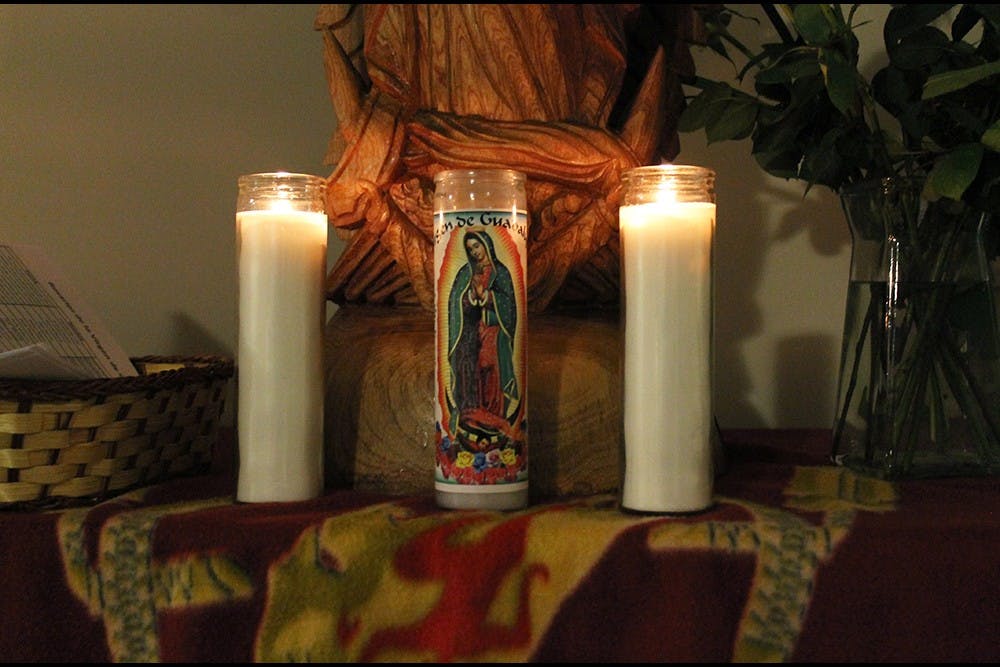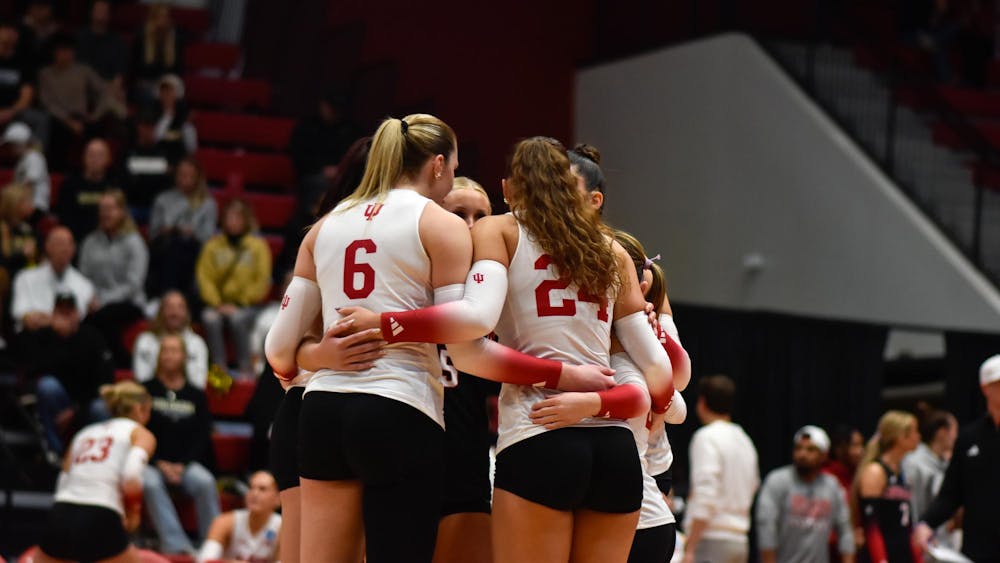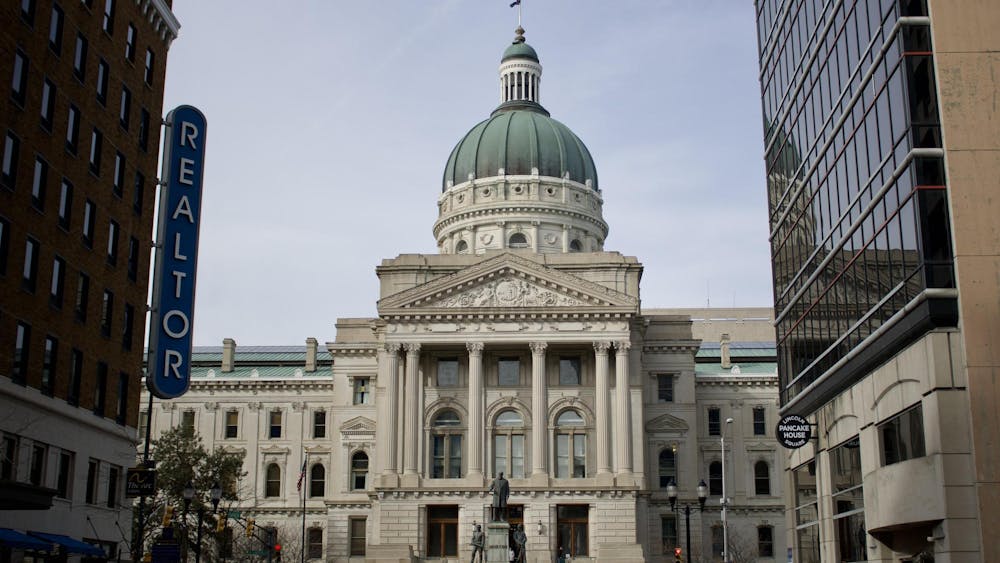A bouquet of roses, three tall candles and 15 praying guests surround an ornate wooden statue of the Virgin of Guadalupe, the patron saint of Mexico.
After prayers, pozole, a traditional Mexican soup of pork and hominy, is passed around. People chat in Spanish about church, their parents and different types of tortillas.
The gathering, in a house on the west side of Bloomington, is as much a religious service as an excuse to get together and enjoy some food, Ilianna Abbot, a native Costa Rican, said.
In Costa Rica, entire blocks of homes open their doors to friends and strangers for the rosary novenas of the Virgin of Guadalupe, she said. People hire bands, cook elaborate multi-course meals and arrange magnificent altars.
For 27 days prior to the day of the Virgin of Guadalupe on Dec. 12, the statue of the Virgin is passed from family to family.
The day of the Virgin of Guadalupe is celebrated primarily by Hispanic Catholics. The holiday represents one way Spanish language and traditions have become an integral part of the changing demographic of the Catholic Church.
In Bloomington, St. Paul’s Catholic Center has begun to adjust to a larger population of Hispanic parishioners. Now, Abbot and other members of the Hispanic community practice the day of the Virgin of Guadalupe at St. Paul’s.
Because it is the only Catholic church in Bloomington that offers services in Spanish, it’s become a social hub for local Hispanics as well as a religious one.
“It provides a second home for us,” Abbot said. “A lot of us don’t have anybody besides our spouses and children, so we live without the support and love of our family. We get to know people, and they’re like family to us.”
The Virgin of Guadalupe
“If you survey probably 100 white Indiana Catholics, the Virgin of Guadalupe would not be important to them,” IU religious studies professor Constance Furey said. “If you surveyed 100 Mexican Hispanic Catholics, you would probably hear that the Virgin of Guadalupe is extremely important to almost all of them.”

On Dec. 9, 1531, Juan Diego, an indigenous man, saw a vision of the Virgin of Guadalupe while on top of the Hill of Tepeyec.
She identified herself as the Virgin Mary and asked Juan Diego to go to the local bishop and build a chapel for her on top of the hill.
The bishop was skeptical and asked Juan Diego for a sign. The Virgin told him to go back to the Hill of Tepeyec and gather flowers, but because it was in the middle of winter, the hill should have been barren.
Despite the season, on Dec. 12, Juan Diego brought his cloak, or tilma, filled with roses, and on the fabric of the cloak was the image of the Virgin of Guadalupe.
Timothy Matovina, an expert on the Virgin of Guadalupe and a professor at Notre Dame, said the Virgin appeared as an indigenous woman speaking in Nahuat, the native language. She represents the blending of the indigenous Indian religion and Catholicism.
“Latinos are a tremendous blessing,” Matovina said. “They are youthful, vibrant and bring evangelical energy. There are ups and downs to the adaptations process, but they are a huge blessing.”
Changes at St. Paul’s
Even small cities like Bloomington are seeing a growing Hispanic population.
According to the U.S. Census Bureau, Bloomington saw a 62-percent increase in its Hispanic population between 2000 and 2010. St. Paul’s has also had a growing attendance at their Spanish-language mass during the last decade, said Valli Youngs, a secretary who has worked with St. Paul’s since 2001.
For St. Paul’s, the transition has been difficult but essential for Hispanic parishioners.
Jay Dolan, a retired Notre Dame history professor, said it's a challenge for churches to bring in priests who speak Spanish, which St. Paul’s experienced first hand.
Rev. Raymond-Marie Bryce’s arrival at St. Paul’s this summer marked the first time there has been a Spanish-speaking priest in the parish since the archdiocese began offering ministry to the Dominicans more than 10 years ago. Before Bryce arrived, a multicultural minister helped translate during mass.
However, parishioners were left frustrated by the quality of the translation. Many people had found the translations and pronunciations distracting, which ultimately resulted in a decrease in attendance.
“Nobody ever got the message across correctly,” Abbot said. “That was one of the reasons I stopped coming for a while too, but when I found out Father Raymond was here, everyone was so excited. We’re still so excited.”
After Bryce’s arrival, confession and other sacraments could be held in Spanish. St. Paul’s has also started Spanish-speaking faith discussion groups, youth services and an upcoming leadership seminar for its Hispanic parishioners.
Hispanic Catholics in the U.S.
According to a 2015 Religious Landscape Study from Pew Research Center, 27 percent of Catholics are born outside the U.S. Thirty-four percent of all Catholics are Hispanic. In Indiana, 15 percent of Catholics are Latino, more than any other minority group, according to Pew.
For Luis Mora and his wife, finding a church that offered Spanish services was essential when they emigrated from Costa Rica six years ago.
In Costa Rica, Mora never really belonged to one church. Instead, he and his wife would attend mass wherever was most convenient.
In Bloomington, that is not an option because only one church offers services in Spanish.
“Coming here to the same mass and seeing the same people every time is a little bit different,” Mora said. “And it being such a small community ... You start feeling more engaged.”
Most of the Spanish mass attendees at St. Paul’s are from Mexico, but there are people from a variety of countries, including Costa Rica and Colombia. Hispanics are the latest wave of Catholic immigrants to settle in Indiana.
“They have their own national gatherings, lobby for their own Latino bishops, have their own parishes where they celebrate their liturgies in a uniquely Latino style and seek to maintain their Latino heritage,” Dolan wrote in his essay about Catholics in the Midwest.
Brother Moises Gutierrez, the director of Intercultural Ministry in Indianapolis, said the majority of Hispanic immigrants have been in Indiana for longer than five years — a result of Hispanic immigrants beginning to settle down in small towns rather than staying in large cities.
Indianapolis churches have started to offer additional programming to Hispanic parishioners. The Archdiocese of Indianapolis offers a variety of services including free immigration assistance and mental health counseling.
Gutierrez said without a strong community, people look to gangs, alcohol and drugs. The church tries to provide parishioners with alternatives.
"We really offer them the possibility to have a community they call home, or they will look for other possibilities,” Gutierrez said. “We want people to find a home where they can get their needs met as much as they can.”
Moving away from the Church
In the culture of the U.S., religion is a choice, Matovina said. Hispanic immigrants are beginning to choose what to — or not to — believe, he added.
Among Hispanics, the younger generation is less likely to be Catholic, according to Pew.
Though it may be in small numbers, Matovina said some Hispanics are turning to Islam, Buddhism and Judaism.
However, the Catholic Church’s adaptation may not be fast enough to keep Hispanic Catholics from converting to a rapidly growing branch of Evangelical Protestantism.
Pentecostalism is quickly spreading in Latin America, as well as parts of the U.S. According to the Pew Research Center, in the U.S., 28 percent of Hispanics who have left Catholicism now consider themselves Pentecostal.
“I think the attraction of Pentecostalism is community, language and belonging,” Dolan said. “Many Catholics gravitate towards this because it’s the opportunity to practice in their own language.”
*The original version of this story misidentified Jay Dolan as Cardinal Timothy Dolan. The IDS regrets this error*






